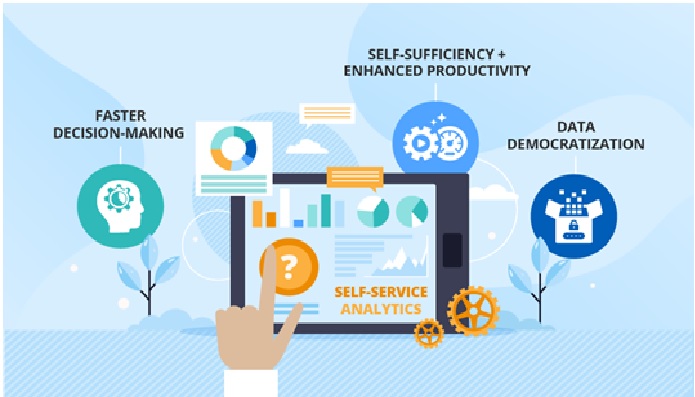Benefits of Using a Self-Service Analytics Tool
The road to creating business value through a well-oiled data management strategy can be long and challenging. A successful data management strategy is one that generates value rapidly and unlocks new data-driven insights. This is done by the mining of raw data into analytics– self-service analytics– that can be shared and used by various teams and consumers across the enterprise.
Self-service analytics, introduced over 30 years ago and iterated upon numerously, enabled data administrators, users, and consumers to move at the speed of the business to build and evolve new data products rapidly. [1]

Figure 1. Benefits of Using a Self-Service Analytics Tool
Figure 1 shows in a traditional BI setting, an end-user might file a request to IT to query data to generate reports or Excel spreadsheets with the data they requested. This method allows IT to maintain more control over data quality but throttles the creativity and insights the business is able to generate quickly.
Alternatively, self-service analytics removes IT as the middleman and allows end-users to drive their own analysis without giving up control of how data is ingested and governed. Removing the IT bottleneck from data analysis activities is a key first step in enabling self-service, but it doesn’t mean taking a hands-off approach. [2]
Benefits of Using a Self-Service Analytics Tool
Greater Data Accessibility:Self-service analytics tools are a requirement for data literacy. Data democratization initiatives must provide a friendly interface for all users to consume insights easily, without requiring extensive training or technical knowledge. In order to successfully create a data literate workforce, users need tools that help them dive deep into data and generate deep insights that aid decisionmaking.
Data Resource Optimization:By reducing dependency on IT, self-service analytics frees up valuable human resources, such as Data Scientists, to focus on larger projects that require manual effort. Their expertise can be put towards complex challenges such as revenue forecasting models, competitive intelligence, and predicting market trends
Greater Data Accuracy:Self-service analytics encourages a single source of truth as all consumers receive data from a centralized data source updated in real time. Today, ad hoc analysis is often done offline in Excel sheets or static reports, resulting in data siloes and outdated insights. Self-service instant insights break through the data siloes that may hamper accuracy. [3]
References:
- https://tdan.com/the-road-to-secure-self-service-analytics/29394
- https://www.phdata.io/blog/what-is-self-service-analytics/
- https://www.macheye.com/blog/what-is-self-service-analytics/
Cite this article:
Thanusri swetha J (2022), Benefits of Using a Self-Service Analytics Tool, AnaTechMaz, pp.134















